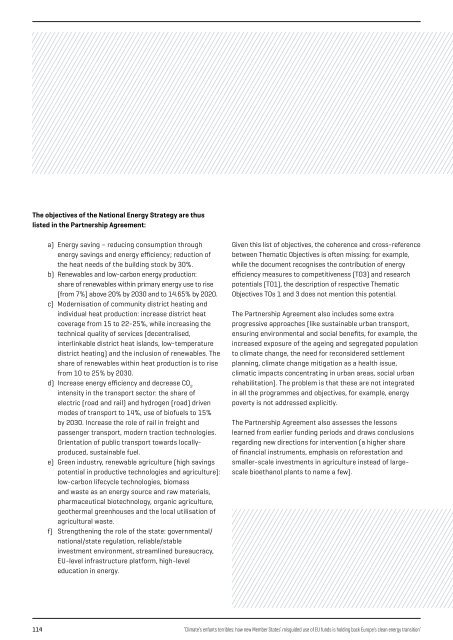ENFANTS TERRIBLES
enfants-terribles
enfants-terribles
You also want an ePaper? Increase the reach of your titles
YUMPU automatically turns print PDFs into web optimized ePapers that Google loves.
The objectives of the National Energy Strategy are thus<br />
listed in the Partnership Agreement:<br />
a) Energy saving – reducing consumption through<br />
energy savings and energy efficiency; reduction of<br />
the heat needs of the building stock by 30%.<br />
b) Renewables and low-carbon energy production:<br />
share of renewables within primary energy use to rise<br />
(from 7%) above 20% by 2030 and to 14.65% by 2020.<br />
c) Modernisation of community district heating and<br />
individual heat production: increase district heat<br />
coverage from 15 to 22-25%, while increasing the<br />
technical quality of services (decentralised,<br />
interlinkable district heat islands, low-temperature<br />
district heating) and the inclusion of renewables. The<br />
share of renewables within heat production is to rise<br />
from 10 to 25% by 2030.<br />
d) Increase energy efficiency and decrease CO 2<br />
intensity in the transport sector: the share of<br />
electric (road and rail) and hydrogen (road) driven<br />
modes of transport to 14%, use of biofuels to 15%<br />
by 2030. Increase the role of rail in freight and<br />
passenger transport, modern traction technologies.<br />
Orientation of public transport towards locallyproduced,<br />
sustainable fuel.<br />
e) Green industry, renewable agriculture (high savings<br />
potential in productive technologies and agriculture):<br />
low-carbon lifecycle technologies, biomass<br />
and waste as an energy source and raw materials,<br />
pharmaceutical biotechnology, organic agriculture,<br />
geothermal greenhouses and the local utilisation of<br />
agricultural waste.<br />
f) Strengthening the role of the state: governmental/<br />
national/state regulation, reliable/stable<br />
investment environment, streamlined bureaucracy,<br />
EU-level infrastructure platform, high-level<br />
education in energy.<br />
Given this list of objectives, the coherence and cross-reference<br />
between Thematic Objectives is often missing: for example,<br />
while the document recognises the contribution of energy<br />
efficiency measures to competitiveness (TO3) and research<br />
potentials (TO1), the description of respective Thematic<br />
Objectives TOs 1 and 3 does not mention this potential.<br />
The Partnership Agreement also includes some extra<br />
progressive approaches (like sustainable urban transport,<br />
ensuring environmental and social benefits, for example, the<br />
increased exposure of the ageing and segregated population<br />
to climate change, the need for reconsidered settlement<br />
planning, climate change mitigation as a health issue,<br />
climatic impacts concentrating in urban areas, social urban<br />
rehabilitation). The problem is that these are not integrated<br />
in all the programmes and objectives, for example, energy<br />
poverty is not addressed explicitly.<br />
The Partnership Agreement also assesses the lessons<br />
learned from earlier funding periods and draws conclusions<br />
regarding new directions for intervention (a higher share<br />
of financial instruments, emphasis on reforestation and<br />
smaller-scale investments in agriculture instead of largescale<br />
bioethanol plants to name a few).<br />
114<br />
‘Climate’s enfants terribles: how new Member States’ misguided use of EU funds is holding back Europe’s clean energy transition’


